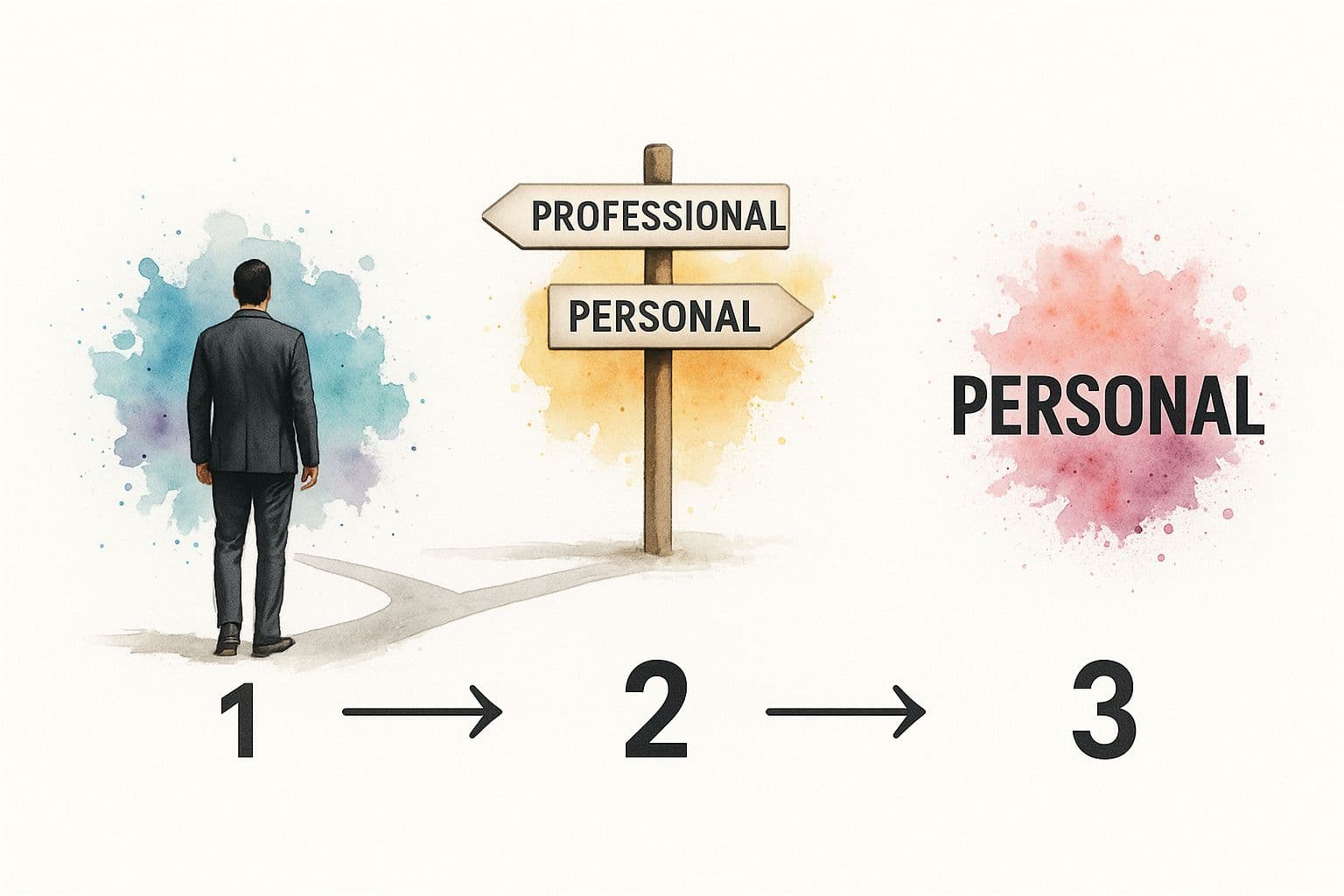Goals are your compass. This guide gives practical, research-backed steps to set SMART professional and personal goals, build a repeatable system, and review progress to achieve them.
June 30, 2025 (6mo ago) — last updated December 15, 2025 (24d ago)
Set and Achieve Professional & Personal Goals
Practical strategies to set SMART professional and personal goals, build systems, and review progress for lasting growth and balance.
← Back to blog
Set and Achieve Professional & Personal Goals
Discover practical, research-backed strategies to set SMART goals, build a repeatable system, and review progress so you actually reach your ambitions.
Introduction
Goals are your compass. Whether you’re aiming for a promotion, better health, or a richer life outside work, clear goals give direction and momentum. This article shows practical steps to define stronger professional and personal goals, build a system that sustains progress, and adapt when life changes.
Why Goal Setting Is a Lifelong Practice
Goal setting isn’t just for New Year’s resolutions or college grads. The most fulfilled people treat goal setting as an ongoing practice. Ambitions evolve as you gain experience and your priorities shift, and that evolution is a sign of growth, not failure.
The Natural Evolution of Goals
Early-career goals often focus on advancement: “I want to get promoted to senior developer within three years.” Once that’s achieved, goals can shift toward mentorship and legacy: “I want to mentor two junior developers and help them get promoted.” The same happens in personal finance: saving for a down payment may become building a retirement portfolio to fund travel and hobbies. These shifts reflect changing priorities and deeper values.
Goal Setting Across Generations
Many adults continue to set goals through midlife and into retirement: 72% of adults aged 35–54 actively set goals, and 62% of adults 55 and older continue to set meaningful goals, often focused on fulfillment and legacy1. This shows goal setting is a skill you sharpen over time, not a phase you outgrow.
Crafting Goals That Actually Work
Vague aspirations like “get a better job” or “be healthier” are a fine starting point, but they rarely produce results. To make progress you need clarity. The SMART framework—Specific, Measurable, Achievable, Relevant, Time-bound—helps turn wishes into executable plans. The science of goal setting shows that specific, challenging goals improve performance and focus2.

Turning Vague Goals into Actionable Steps
A vague goal like “I want to be a better leader” becomes actionable as: “I will complete a certified leadership course and volunteer to lead two internal projects by the end of Q3.” Now you have concrete steps, a deadline, and a way to measure success.
For personal goals, “I want to get in shape” becomes: “I will work out three times a week following a structured program and reduce sugar intake by 50% over the next three months.” Specifics create accountability and momentum.
Examples: Vague Goal → SMART Objective
| Vague Goal | SMART Objective |
|---|---|
| “I want to learn a new skill.” | “I will complete an online Python course on Coursera and build a small web app by December 31 to add a tangible skill to my resume.” |
| “I want to save more money.” | “I will set an automatic transfer of $300 per month into a high-yield savings account to build a $3,600 emergency fund in 12 months.” |
| “I should network more.” | “I will attend one industry event each quarter and schedule two virtual coffee chats per month to grow my network.” |
Specific goals create accountability. You’re no longer hoping for results; you’re following a plan.
Finding Synergy Between Professional and Personal Goals

Professional and personal goals often feel like they compete for your time. The better approach is to identify shared values—discipline, resilience, long-term vision—and design goals that support each other. When values align, progress in one area fuels the other.
Create an Integrated Action Plan
Instead of compartmentalizing, look for ways tasks can serve dual purposes. Use a long training run to think through business challenges, or turn a focused work block into time to practice habits that build discipline. An integrated schedule might look like:
- Morning run (60 minutes): physical training and uninterrupted time for strategic thinking.
- Deep work block (4 hours): focused effort on high-impact work.
- Afternoon walk (15 minutes): active recovery and mental reset.
This creates a feedback loop where physical energy boosts clarity, and professional wins motivate personal consistency.
Building a Personal Goal Achievement System

A goal is only as good as the system that supports it. Break big goals into small, repeatable actions. If your goal is to write a book, your system’s first task might be “outline Chapter 1.” Systems make progress inevitable by focusing on the next small step.
Choose Tools That Fit Your Style
Pick tools you’ll actually use. A few proven options:
- Kanban boards (Trello, Asana) for visual task flow.
- Digital notebooks (Notion, Evernote) to centralize goals and research.
- To-do apps (Todoist, Microsoft To Do) for habit tracking and daily tasks.
Experiment for a few weeks and adjust. The best system is the one you keep using.
Turn Progress into Data
Track measurable indicators: outreach emails per week for client growth, workouts per week for fitness, or conversion rates for sales. Data reveals where the system is breaking down and what to delegate. When you measure progress, you can course-correct before problems compound.
Mastering the Review and Adapt Cycle
Setting goals is the first step; reviewing and adapting them is where long-term success happens. A simple review rhythm keeps goals aligned with reality and prevents wasted effort.
Establish a Review Rhythm
Treat reviews as scheduled conversations with your future self:
- Weekly check-in (15–30 minutes): tactical review of tasks and obstacles.
- Monthly review (1 hour): evaluate whether weekly actions are building toward quarterly objectives.
- Quarterly retreat (half-day): big-picture reassessment and intentional pivots.
Adapting a goal isn’t failure; it’s smart responsiveness. The most successful people adjust their direction when circumstances change.
Pivoting with Intention
If an organizational reorg removes a path to promotion, reframe the underlying ambition. If you wanted leadership, a pivot could be: “I will secure a senior individual contributor role that leads high-impact projects and mentors junior colleagues within six months.” This preserves the core aim while adapting to new reality.
Frequently Asked Questions
What if I fail to achieve a goal?
Missing a target is not a personal failure; it’s a data point. Ask what went wrong: Was the goal realistic? Did priorities change? Did you have the tools and support needed? Use the answers to recalibrate timelines, break goals into smaller steps, or change direction.
How do I stay motivated when progress is slow?
Action creates motivation. Focus on the next tiny, achievable step—write for 15 minutes, send one outreach email—and celebrate small wins. The Progress Principle shows that consistent, visible progress fuels motivation and engagement3.
How many goals should I work on at once?
Focus on one to three major goals at a time. Protect that focus ruthlessly. You can maintain smaller habit goals concurrently, but spreading attention across too many big goals leads to burnout and shallow results.
Q&A — Concise Answers to Common Questions
How do I make a vague goal measurable?
Add specific actions, a metric, and a deadline. For example: “I will complete X course, finish Y project, and achieve Z result by [date].”
What tools help me stick to goals?
Pick simple tools you’ll use: a paper journal, Trello for kanban boards, Notion for centralized planning, or Todoist for daily habits.
How often should I reassess my goals?
Weekly tactical checks, monthly progress reviews, and quarterly strategy sessions work well for most people.
Ready to simplify task management and focus on what matters? Fluidwave offers tools and on-demand virtual assistants to help you create, prioritize, and delegate tasks without a subscription. Get started for free at https://fluidwave.com.
Focus on What Matters.
Experience lightning-fast task management with AI-powered workflows. Our automation helps busy professionals save 4+ hours weekly.